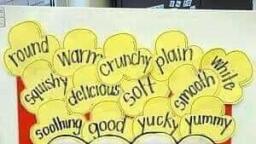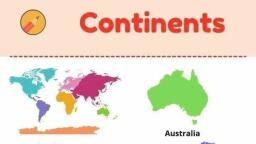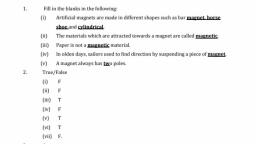Question 2 :
A magnet was brought from different directions towards a toy boat that has been floating in water in a tub. Boat moves away from the magnet when north pole is brought near its head. Which of the following is a reason for this?
Question 3 :
Similar poles of a magnet repel each other. State true or false.
Question 4 :
<img style='object-fit:contain' src='https://teachmint.storage.googleapis.com/question_assets/cbse_ncert/61b1c672f59b460d7261e5fc.jpg' />
A bar magnet is cut into two pieces A and B, from the middle, as shown in figure above Will the two pieces act as individual magnets?
Question 7 :
The given shows different positions in which one pole of a magnet is placed near that of the other. The answer indicates the resulting action between the two poles.
[ N - ? ] = Attraction
Question 8 :
A magnet was brought from different directions towards a toy boat that has been floating in water in a tub. Boat gets attracted towards pole magnet. Which of the following is a reason for this?
Question 9 :
<img style='object-fit:contain' src='https://teachmint.storage.googleapis.com/question_assets/cbse_ncert/61b1c6e0f59b460d7261e645.jpg' />
Does the magnet with iron filings sticking to it, look like any one of those shown in above figure?
Question 11 :
<img style='object-fit:contain' src='https://teachmint.storage.googleapis.com/question_assets/cbse_ncert/61b1c6e7f59b460d7261e64f.jpg' />
A person takes two small toy cars and labels them A and B. He places a bar magnet on top of each car along its length and fix them with rubber bands as shown in the figure. In car A, keep the south pole of the magnet towards its front. Place the magnet in opposite direction in car B. Now, he places the two cars close to one another as shown in the figure. Do the cars remain at their places?
Question 12 :
<img style='object-fit:contain' src='https://teachmint.storage.googleapis.com/question_assets/cbse_ncert/61b1c6e7f59b460d7261e650.jpg' />
A person takes two small toy cars and labels them A and B. He places a bar magnet on top of each car along its length and fix them with rubber bands as shown in the figure. In car A, keep the south pole of the magnet towards its front. Place the magnet in opposite direction in car B. Now, he places the two cars close to one another as shown in the figure. Do the cars run away from each other?
Question 13 :
Fill in the blank:
In a bar magnet, magnetic attraction is ............... near its ends.
Question 14 :
State true or false:
Maximum iron filings stick in the middle of a bar magnet when it is brought near them.
Question 15 :
A magnet was brought from different directions towards a toy boat that has been floating in water in a tub. Boat is not affected by the magnet. Which of the following is a reason for this?
Question 16 :
Maximum iron filings stick in the middle of a bar magnet when it is brought near them. State true or false.
Question 17 :
<img style='object-fit:contain' src='https://teachmint.storage.googleapis.com/question_assets/cbse_ncert/61b1c6e3f59b460d7261e64a.jpg' />
Spread some iron filings on a sheet of paper. Now, place a bar magnet on this sheet. Do you observe that more iron filings get attracted to some parts of the magnet than others as shown in the figure?
Question 18 :
<img style='object-fit:contain' src='https://teachmint.storage.googleapis.com/question_assets/cbse_ncert/61b1c6e5f59b460d7261e64c.jpg' />
A person takes a bar magnet and puts a mark on one of its ends for identification. Now, he ties a thread at the middle of the magnet so that he can suspend it from a wooden stand as shown in the figure. He makes sure that the magnet can rotate freely. Now, he lets it come to rest. He marks two points on the ground to show the position of the ends of the magnet when it comes to rest. Next, he rotates the magnet by gently pushing one end in any direction and lets it come to rest. Again, he marks the position of the two ends in its position of rest. Does the magnet now point in a different direction?
Question 19 :
Bar magnets always point towards North-South direction. State true or false.
Question 20 :
A person rubs a magnet in the sand or soil and then pulls out the magnet. Now, he gently shakes the magnet to remove the particles of sand or soil. Are some particles still sticking to it?
Question 21 :
Fill in the blank:
When a bar magnet is broken; each of the broken part will have ................ pole/poles.
Question 22 :
Fill in the blank:
North pole of a magnet can be identified by ____.
Question 23 :
Fill in the blank:
A bar magnet is immersed in a heap of iron filings and pulled out. The amount of iron filling clinging to the ______.
Question 24 :
In olden days, sailors used to find direction by suspending a piece of ___________.
Question 25 :
<img style='object-fit:contain' src='https://teachmint.storage.googleapis.com/question_assets/cbse_ncert/61b1c6e5f59b460d7261e64d.jpg' />
A person takes a bar magnet and puts a mark on one of its ends for identification. Now, he ties a thread at the middle of the magnet so that he can suspend it from a wooden stand as shown in the figure. He makes sure that the magnet can rotate freely. Now, he lets it come to rest. He marks two points on the ground to show the position of the ends of the magnet when it comes to rest. Next, he rotates the magnet by gently pushing one end in any direction and lets it come to rest. Again, he marks the position of the two ends in its position of rest. Do you find that the magnet always comes to rest in the same direction?
Question 27 :
Choose the correct option(s) for : Poles of the magnet can be identified by
Question 28 :
Fill in the blanks: Artificial magnets are made in different shapes such as __________, __________ and ____________.
Question 29 :
The given shows different positions in which one pole of a magnet is placed near that of the other. The answer indicates the resulting action between them for each situation. [ ? - S ] = Repulsion
Question 30 :
<img style='object-fit:contain' src='https://teachmint.storage.googleapis.com/question_assets/cbse_ncert/61b1c6e8f59b460d7261e651.jpg' />
A person takes two small toy cars and labels them A and B. He places a bar magnet on top of each car along its length and fix them with rubber bands as shown in the figure. In car A, keep the south pole of the magnet towards its front. Place the magnet in opposite direction in car B. Now, he places the two cars close to one another as shown in the figure. Do they move towards each other and collide?
Question 31 :
<img style='object-fit:contain' src='https://teachmint.storage.googleapis.com/question_assets/cbse_ncert/61b1c6e1f59b460d7261e647.jpg' />
What materials did you find to be non-magnetic from the above Table?
Question 32 :
You are given an iron strip. How will you make it into a magnet?
Question 33 :
The materials which are attracted towards a magnet are called _______.
Question 34 :
Spread some iron filings on a sheet of paper. Now, place a bar magnet on this sheet. Do the iron filings stick all over the magnet?
Question 35 :
N - N shows positions in which one pole of a magnet is placed near that of the other. Which of the following action indicates this?
Question 36 :
<img style='object-fit:contain' src='https://teachmint.storage.googleapis.com/question_assets/cbse_ncert/61b1c678f59b460d7261e604.jpg' />
Boojho dipped a bar magnet in a heap of iron filings and pulled it out. He found that iron filings got stuck to the magnet as shown in above figure . The regions on which iron filling gets sticked is called?
Question 37 :
In olden days, sailors used to find direction by suspending a piece of _______.
Question 38 :
Paheli has this puzzle for you. You are given two identical bars which look as if they might be made of iron. One of them is a magnet, while the other is a simple iron bar. How will you find out, which one is a magnet?
Question 39 :
<img style='object-fit:contain' src='https://teachmint.storage.googleapis.com/question_assets/cbse_ncert/61b1c674f59b460d7261e5ff.JPG ' />
The arrangement to store two magnets is shown by above figures (a), (b), (c) and (d) in Figure shown above. Which one of them is the correct arrangement?
Question 41 :
<img style='object-fit:contain' src='https://teachmint.storage.googleapis.com/question_assets/cbse_ncert/61b1c677f59b460d7261e603.jpg' />
Boojho dipped a bar magnet in a heap of iron filings and pulled it out. He found that iron filings got stuck to the magnet as shown in above figure . Which regions of the magnet have more iron filings sticking to it ?
Question 42 :
<img style='object-fit:contain' src='https://teachmint.storage.googleapis.com/question_assets/cbse_ncert/61b1c6e2f59b460d7261e648.jpg' />
Is there any material common in all the objects in the table that were attracted by the magnet?
Question 43 :
<img style='object-fit:contain' src='https://teachmint.storage.googleapis.com/question_assets/cbse_ncert/61b1c6e4f59b460d7261e64b.jpg' />
A person takes a plastic or wooden scale and puts a mark on one of its ends for identification. Now, he ties a thread at the middle so that he can suspend it from a wooden stand as shown in the figure. He makes sure that the scale can rotate freely. Now, he lets it come to rest. He marks two points on the ground to show the position of the ends of the scale when it comes to rest. Next, he rotates the scale by gently pushing one end in any direction and lets it come to rest. Again, he marks the position of the two ends in its position of rest. Do you find that the scale always comes to rest in the same direction?
Question 46 :
Spread some iron filings on a sheet of paper. Now, place a bar magnet on this sheet. What do you observe?
Question 47 :
State true or false:
A cylindrical magnet has only one pole.
Question 48 :
State true or false:
Bar magnets always point towards North-South direction.
Question 49 :
The given shows different positions in which one pole of a magnet is placed near that of the other. The answer indicates the resulting action between them for each situation. [ S - N ] = ?
Question 50 :
,<img style='object-fit:contain' src='https://teachmint.storage.googleapis.com/question_assets/cbse_ncert/61b1c676f59b460d7261e602.jpg' />
Four identical iron bars were dipped in a heap of iron filings one by one. The above figure shows the amount of iron filings sticking to each of them. Which of the iron bar is likely to be the strongest magnet ?


















































